Birdfinding.info ⇒ Common and familiar across much of eastern and northern Australia, especially in the southeast, roughly from Brisbane to Melbourne, where it has adapted to developed landscapes, including cities. Consistent sites for some introduced populations include: in New Zealand, the western hills of Auckland; in Singapore, Sentosa Island and the Southern Ridges; and in Taipei, Guizikeng Park. (For the New Guinean form, see “Triton Cockatoo”.)
Sulphur-crested Cockatoo
Cacatua galerita
Australia, Tasmania, New Guinea, and adjacent islands. Comprises two distinct forms: the “Sulphur-crested Cockatoo” (galerita) of Australia and the “Triton Cockatoo” (triton) of New Guinea.
“Sulphur-crested Cockatoo” is widespread across most of northern and eastern Australia, from West Kimberley east through the northern half of the Northern Territory and almost all of Queensland (except the southwestern interior), then south through almost all of New South Wales, all of Victoria, and the southeastern quadrant of South Australia.
Occurs in various forested and semiopen habitats, including urban and agricultural areas. Often forages on open ground—much more often than other large Cacatua cockatoos.
In the south, also occurs on Tasmania, Kangaroo Island, and King Island (Bass Strait). In the north, also on the Tiwi Islands, Groote Eylandt, and the larger islands of the Torres Strait.
Populations of the Northern Territory and adjacent Queensland (west of Nicholson River) are recognized as a separate subspecies, fitzroyi. Those of northern Queensland (east of the Gulf of Carpentaria) have sometimes been recognized as queenslandica, but most authorities currently place them within galerita.
Introduced populations of galerita are well-established in New Zealand on North Island (several areas) and South Island (in Prices Valley south of Christchurch, and in the far south around Caitlins River).
Smaller urban populations are also established around Hong Kong and Singapore, and on Taiwan around Taipei, Chiayi, and Kaohsiung; formerly also Taichung.
Escapees occasionally turn up in various places around the globe, sometimes forming small feral groups which may persist for many years, often with other cockatoo species. Some areas where such groups have persisted without apparent expansion include: Honolulu, Manila, Nassau (Bahamas), and Perth.
“Triton Cockatoo” occupies New Guinea and many adjacent islands to its northwest and southeast: Waigeo, Gam, Kofiau, Misool, Batanta, Salawati, Numfoor, Biak, Num, Japen, the Trobriand Islands, Goodenough, Fergusson, Normanby, and the Louisiade Archipelago.
Unlike “Sulphur-crested”, the “Triton Cockatoo” is exclusively arboreal and usually found in forest.
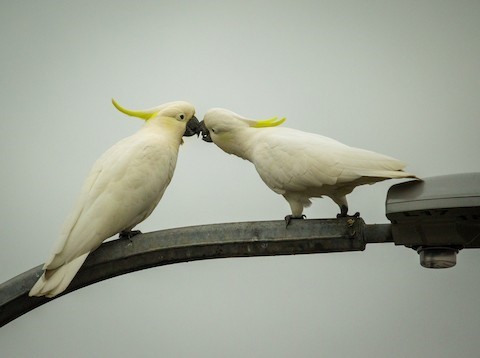
Urban-adapted Sulphur-crested Cockatoos bonding on a streetlight. (Oatlands, New South Wales, Australia; June 8, 2019.) © Kent Warner
The subspecies eleonora is native to the Aru Islands south of western New Guinea, and has reportedly been introduced to the nearby Kai Islands.
An introduced population of Sulphur-crested Cockatoos that is well-established in Palau, across most of the main archipelago, is attributed to triton.
Identification
A large white cockatoo with a luxuriant yellow crest. Immediately recognizable except for potential confusion with the closely related, lesser-known Yellow-crested and Blue-eyed Cockatoos. (For a detailed comparison of the several similar forms in this complex, see Identification of Yellow-crested Cockatoos.)

Sulphur-crested Cockatoo foraging on an urban lawn with its sulphur crest fully extended. (Oatlands, New South Wales, Australia; June 8, 2019.) © Kent Warner
The frontal feathers of the crest are white, and the middle and hind-crown feathers are pale-yellow, long, and up-curved—so their tips point forward when the crest is raised. At rest, the white shield partly obscures the yellow feathers.
Sulphur-crested often shows a subtle yellowish patch on the cheeks or ear-coverts.
The orbital skin is white on most Australian Sulphur-crested. It can also be subtly bluish, but this is much more typical of the New Guinean “Triton Cockatoo”.
As in other predominantly white cockatoos, the undersides of the wings and tail are suffused with yellow.
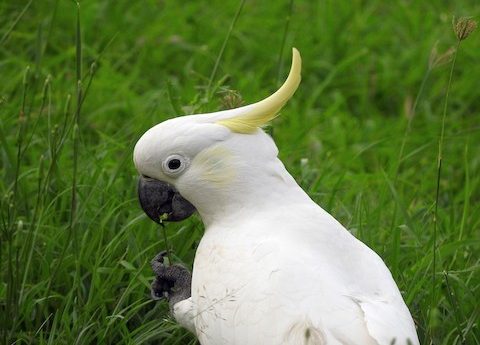
Sulphur-crested Cockatoo, foraging on the ground with its sulphur crest flattened. (Gold Creek Reservoir, Brisbane, Queensland, Australia; October 9, 2017.) © Chris Burwell
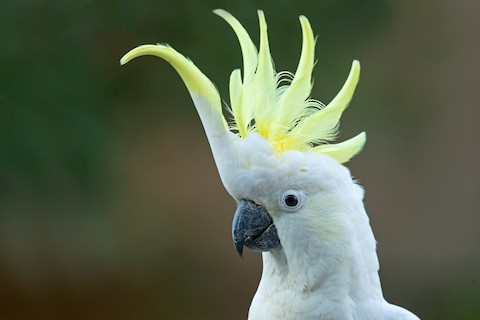
Sulphur-crested Cockatoo with its sulphur crest fully extended. (Parramatta, New South Wales, Australia; May 3, 2020.) © David Irving
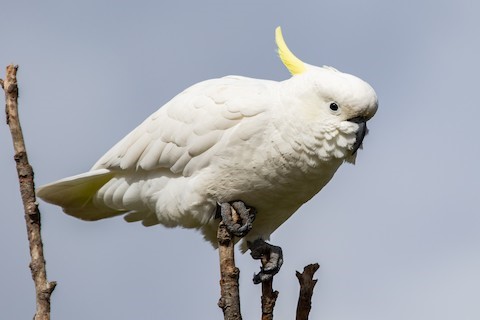
Sulphur-crested Cockatoo with facial feathers concealing the bill—note proportionately large body and small head. (Lorne Foreshore Reserve, Victoria, Australia; September 24, 2019.) © Ramit Singal

Sulphur-crested Cockatoo, dorsal view during upside-down acrobatic maneuver. (Les Davies Park, Cairns, Queensland, Australia; August 27, 2020.) © Mark and Angela McCaffrey

Sulphur-crested Cockatoo, dorsal view in flight. (Mulanggari Grasslands Nature Reserve, Australian Capital Territory, Australia; July 17, 2020.) © David Irving
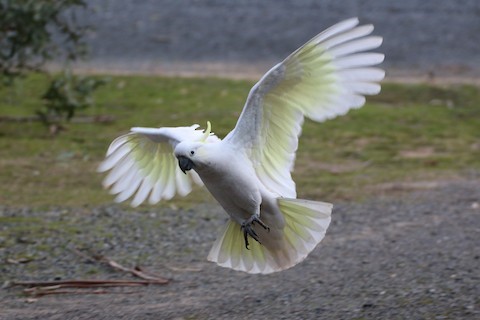
Sulphur-crested Cockatoo, showing pale-yellow wash on the undersides of the wings and tail. (Halls Gap, Grampians National Park, Victoria, Australia; August 1, 2015.) © Mark Broomhall
“Triton Cockatoo”. Like typical Sulphur-crested, but smaller, and often has noticeably bluish orbital skin.
Compared to the much more familiar Australian populations of Sulphur-crested, “Triton” gives the impression of a smaller bird—proportioned differently, with a large bill and large head, closer to the proportions of a typical Yellow-crested.
“Triton” also differs from Australian Sulphur-crested in being almost exclusively arboreal
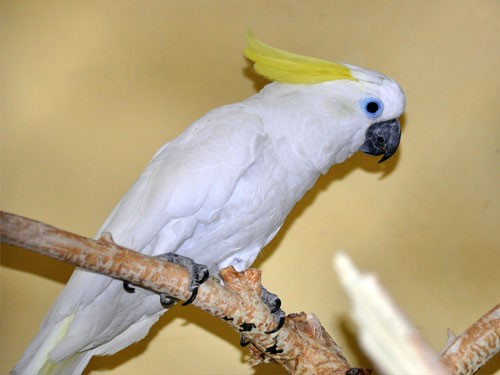
“Triton Cockatoo”, C. g. triton, close-up view of a captive individual, showing vivid powder-blue orbital skin. (Grodno Zoo.) © Zoo Institutes
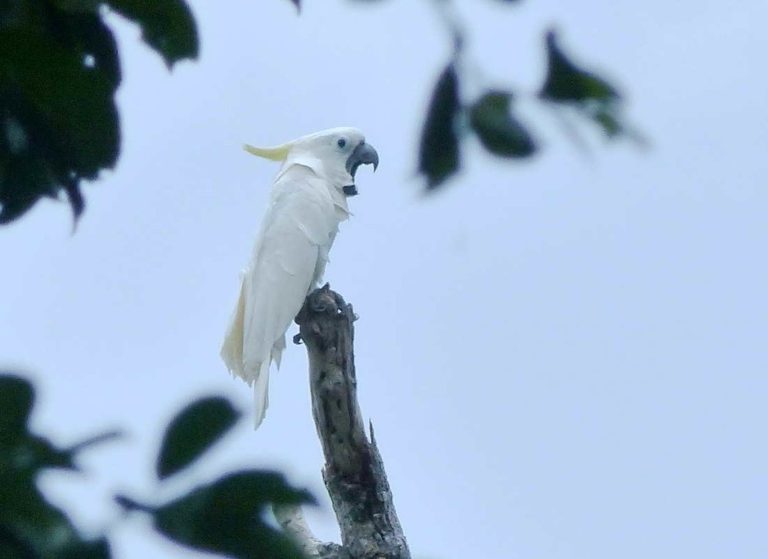
“Triton Cockatoo”, C. g. triton, vocalizing—note the proportionately big-headed, big-billed appearance, and the inconspicuousness of the bluish orbital skin. (Sapokreng, Waigeo, West Papua, Indonesia; October 29, 2017.) © Benoit Segerer
Voice. Most typical calls are harsh, hoarse, cacophonous screeches: “Triton’s” calls generally seem less harsh and more mournful than those of Australian Sulphur-crested:
Notes
Polytypic species consisting of four recognized subspecies, representing two distinct forms: “Sulphur-crested Cockatoo” (galerita plus fitzroyi) of Australia and “Triton Cockatoo” (triton plus eleonora) of New Guinea and adjacent islands.
Additional Photos of Sulphur-crested Cockatoo
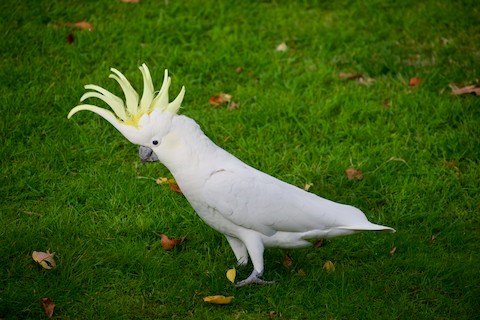
Sulphur-crested Cockatoo with its sulphur crest fully extended. (Warburton, Victoria, Australia; May 20, 2019.) © Lance Rathbone
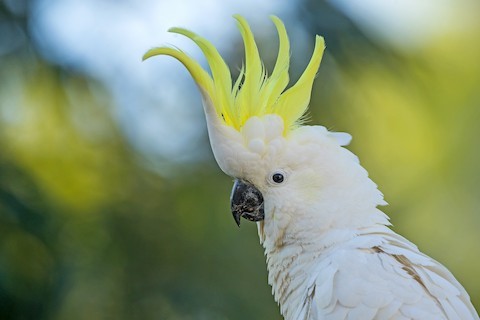
Sulphur-crested Cockatoo with its sulphur crest fully extended. (Parramatta, New South Wales, Australia; May 3, 2020.) © David Irving
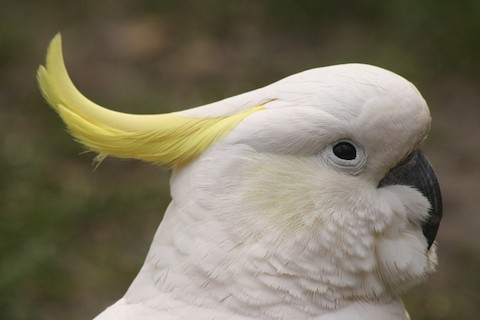
Sulphur-crested Cockatoo, with crest flattened and facial feathers concealing the bill. (Dandenong, Victoria, Australia; September 28, 2010.) © Rémi Bigonneau
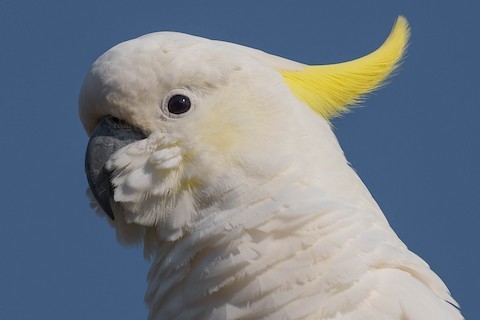
Sulphur-crested Cockatoo, with crest flattened and facial feathers concealing the bill—note faint yellowish wash on the cheek. (Hemmant, Queensland, Australia; December 7, 2019.) © Terence Alexander

Sulphur-crested Cockatoo. (Lorne Foreshore Reserve, Victoria, Australia; January 9, 2020.) © Brendan Fogarty

Sulphur-crested Cockatoo, facial close-up. (Royal Botanic Gardens, Sydney, New South Wales, Australia; March 20, 2018.) © Bridget Spencer

Sulphur-crested Cockatoo in a typical posture with crested raised. (Eynesbury, Victoria, Australia; May 21, 2016.) © Andrew Allen
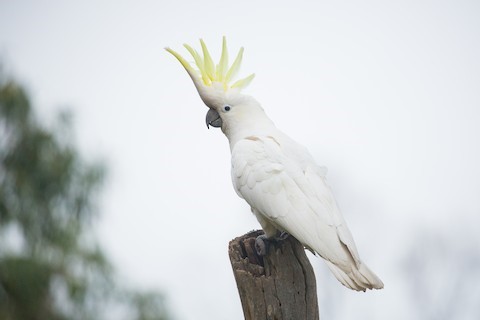
Sulphur-crested Cockatoo, showing fully extended yellow crest. (Spavin Drive Lake, Sunbury, Victoria, Australia; August 7, 2020.) © Neil Bloem
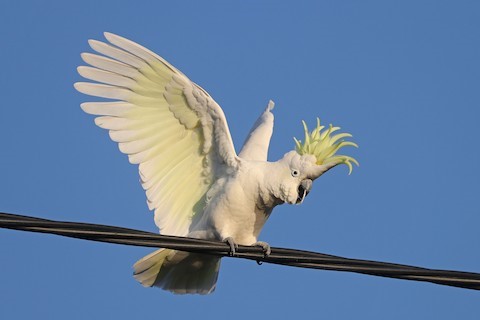
Sulphur-crested Cockatoo, showing fully extended yellow crest and yellow wash on the undersides of the wings and tail. (Dowse Lagoon, Sandgate, Queensland, Australia; August 13, 2019.) © Rick Franks

Sulphur-crested Cockatoo, with plumage apparently discolored by dust-bathing. (Nudgee Waterhole Reserve, Queensland, Australia; August 24, 2019.) © Hayley Alexander

Sulphur-crested Cockatoo, dorsal view, with fully extended yellow crest. (Wanniassa, Australian Capital Territory, Australia; January 21, 2019.) © Sandra Henderson

Sulphur-crested Cockatoo, frontal view, showing fully extended yellow crest. (Tidbinbilla Nature Reserve, Australian Capital Territory, Australia; February 18, 2018.) © Geoff Hill
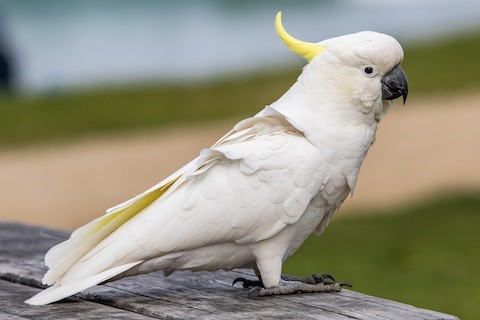
Sulphur-crested Cockatoo on a picnic table, with its crest lowered. (Lorne Foreshore Reserve, Victoria, Australia; September 24, 2019.) © Ramit Singal
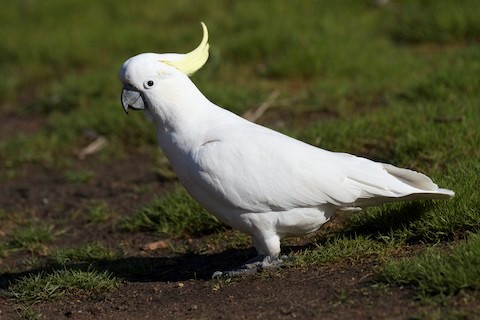
Sulphur-crested Cockatoo with crest flattened. (Lake Tuggeranong, Australian Capital Territory, Australia; October 2, 2016.) © Chris Barnes
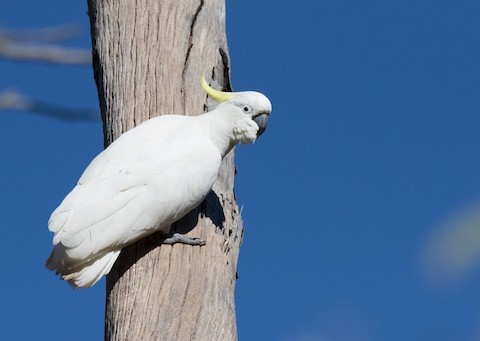
Sulphur-crested Cockatoo, showing the bulky, lanky frame of a large cockatoo—which differentiates it from the nearly identical but smaller Yellow-crested Cockatoo. (Miles, Queensland, Australia; May 16, 2021.) © Chris Barnes
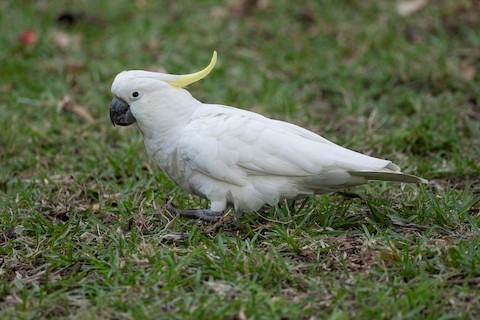
Sulphur-crested Cockatoo with crest flattened. (Royal Botanic Gardens, Sydney, New South Wales, Australia; September 25, 2019.) © Michael Linz
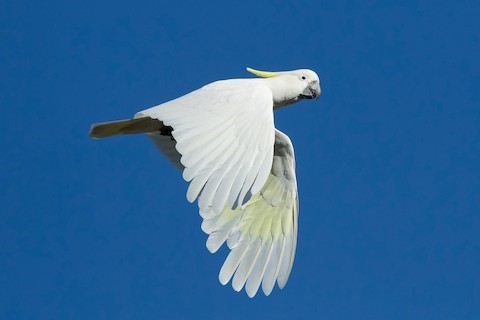
Sulphur-crested Cockatoo in flight. (Parramatta, New South Wales, Australia; May 16, 2021.) © David Irving

Sulphur-crested Cockatoo in flight. (Danthonia, New South Wales, Australia; August 18, 2018.) © Rufus Wareham
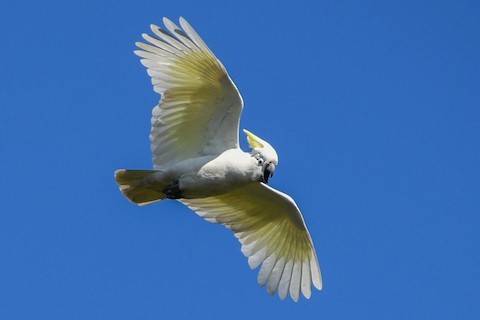
Sulphur-crested Cockatoo, showing yellow wash on the undersides of the wings and tail. (Royal Botanic Gardens, Sydney, New South Wales, Australia; July 22, 2017.) © Maryse Neukomm
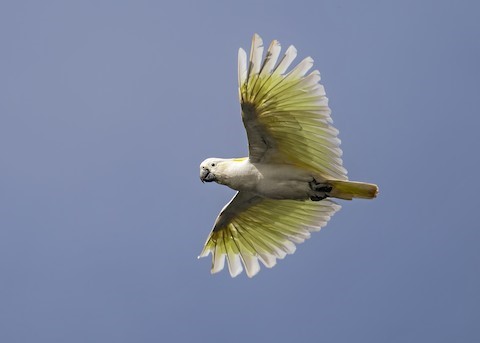
Sulphur-crested Cockatoo, showing yellow wash on the undersides of the wings and tail. (Yerrabi Pond, Canberra, Australia; February 23, 2018.) © Julie Clark
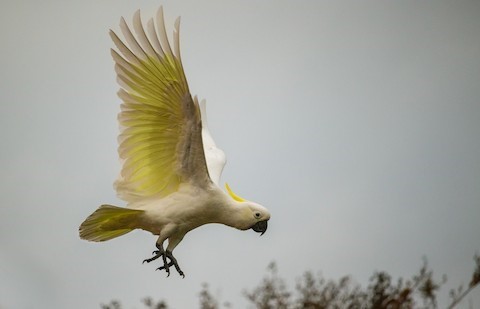
Sulphur-crested Cockatoo, showing yellow wash on the undersides of the wings and tail. (Oatlands, New South Wales, Australia; June 8, 2019.) © Kent Warner

Sulphur-crested Cockatoo, showing yellow wash on the undersides of the wings and tail. (Oatlands, New South Wales, Australia; June 8, 2019.) © Kent Warner
References
BirdLife International. 2018. Cacatua galerita. The IUCN Red List of Threatened Species 2018: e.T22684781A131914971. https://dx.doi.org/10.2305/IUCN.UK.2018-2.RLTS.T22684781A131914971.en. (Accessed August 24, 2021.)
Brazil, M. 2009. Birds of East Asia. Princeton University Press.
eBird. 2021. eBird: An online database of bird distribution and abundance. Cornell Lab of Ornithology, Ithaca, N.Y. http://www.ebird.org. (Accessed August 24, 2021.)
Forshaw, J.M. 2010. Parrots of the World. Princeton University Press.
Juniper, T., and M. Parr. 1998. Parrots: A Guide to Parrots of the World. Yale University Press.
Kirwan, G.M., A. Levesque, M. Oberle, and C.J. Sharpe. 2019. Birds of the West Indies. Lynx Edicions, Barcelona.
Lin, R.S. and P.F. Lee. 2006. Status of Feral Populations of Exotic Cockatoos (Genus Cacatua) in Taiwan. Tawania 51:188-194.
Xeno-Canto. 2021. Sulphur-crested Cockatoo – Cacatua galerita. https://www.xeno-canto.org/species/Cacatua-galerita. (Accessed August 24, 2021.)

